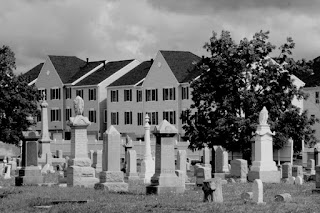I bought my car a new water pump for Christmas - a
surprise gift for both of us. It had been slowly leaking coolant for the last
few months so I’ve been slowly considering having it checked out. It was one of
those situations familiar to any car owner - you expect it to be a leaking hose and it turns out to be a $450
repair.
 |
| Riverview Cemetery, Wilmington, Delaware |
When they broke the news to me that I needed a new water
pump, I was easting brefass at McDonald’s down the road. Not my first choice,
but since the wonderful greasy-spoon old Post
House Diner across the street closed (!) since my last visit, I had no
choice. The Post House was actually
a Pony Express stop back in the 1800s, if you can believe that! I don’t think
they’d scraped the grease off the grills since that time (which, of course, added extra flavor to the food). So there I was with an extra two hours on my hands. May as
well walk up to Riverview Cemetery, there on Market Street in Wilmington.
Restaurants may close up shop, but you can rely on a cemetery to keep its doors
open for you.
Riverview is actually about two miles from the Delaware
River, so there is no actual river view. It’s bisected by North Market Street,
the north side of the cemetery being newer with some grand monuments and
mausoleums. The south side is older, with quite meager stones and grave
markers. I’d never spent much time on the south side, but seeing as I had a couple hours, why not?
 |
| Dupont Nemours Mansion, Wilmington, DE (ref) |
 |
| Old and new (condos) construction, Riverside Cemetery, Wilmington, DE |
Riverview has been in operation since 1872, with a few glitches along the way. Most recently, the cemetery had been abandoned (I’m guessing for at least a decade between the mid- 1990s to the mid 2000s). In 2009 it was taken over by a Friends group which is, of course, the best Christmas present an abandoned cemetery can receive. Since then, it has been cleaned up and there are active burials occurring.
I remember walking around the newer side of the cemetery ten
years ago and the weeds were a couple feet high. There are early-2000s accounts
on the web of descendants trying in vain to get information about family
interred at Riverview. Supposedly, people were being buried with no records being
kept at all, and several homeless people were sleeping in the cemetery. Typical
occurrences in an abandoned cemetery. All that appears to have changed.
 It was cold on water pump day as I walked around the old side of
Riverview Cemetery, so I only spent about an hour there. However, something unusual
caught my eye the moment I set foot on the grounds. There were many – and I
mean scores of − old marble headstones
lying face up in the ground, carefully excavated out of the sod. Some were
flush with the grass, with their edges carefully weed-whacked, others obviously
dug out of several inches of soil and cleaned off – possibly for the first time
in decades.
It was cold on water pump day as I walked around the old side of
Riverview Cemetery, so I only spent about an hour there. However, something unusual
caught my eye the moment I set foot on the grounds. There were many – and I
mean scores of − old marble headstones
lying face up in the ground, carefully excavated out of the sod. Some were
flush with the grass, with their edges carefully weed-whacked, others obviously
dug out of several inches of soil and cleaned off – possibly for the first time
in decades. |
| Excavated headstone, Riverview Cemetery |
If I had not given my cemetery sleigh a new water pump that day, I would not have had the time to make such a studied visit to Riverview Cemetery. While I wasn’t thrilled to drop $450, I’m glad to have spent so much time here, to appreciate the small details I could have easily missed. The visit subsequently gave me a reason to do some related web searching. It was so heartening to discover the existence of the Friends group, an on-line presence for the cemetery, and contact information – all evidence that people care a great deal about their history. Merry Christmas − I’ll leave you with this notation from the Riverview Cemetery website (http://www.riverviewcem.com/news07.htm):
Riverview's early interment books list cause of death and
some terms such as Apoplexy, Dropsy, Bright's Disease, and La Grippe were not
familiar to us. So we have defined a few terms: Apoplexy was used to describe
any sudden death that began with a sudden loss of consciousness; heart attack
and ruptured cerebral or aortic aneurysms fall under this category. Dropsy or
edema refer to the same condition; an increase in interstitial fluid in any
organ resulting in swelling. Bright's disease is a historical classification of
kidney diseases first described in 1827. La Grippe was one of several names
used to describe the influenza that caused a flu pandemic in 1918."
References and Further Reading:
Riverview Cemetery website






























